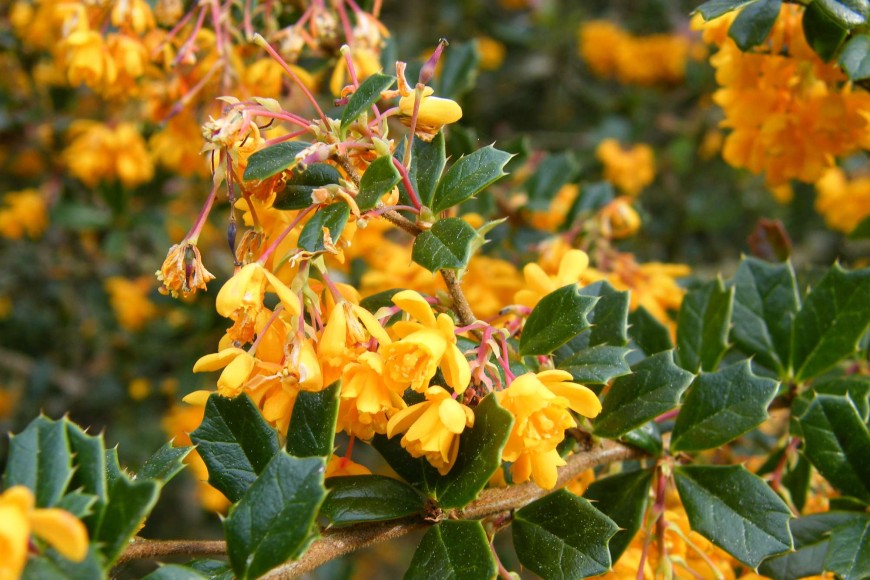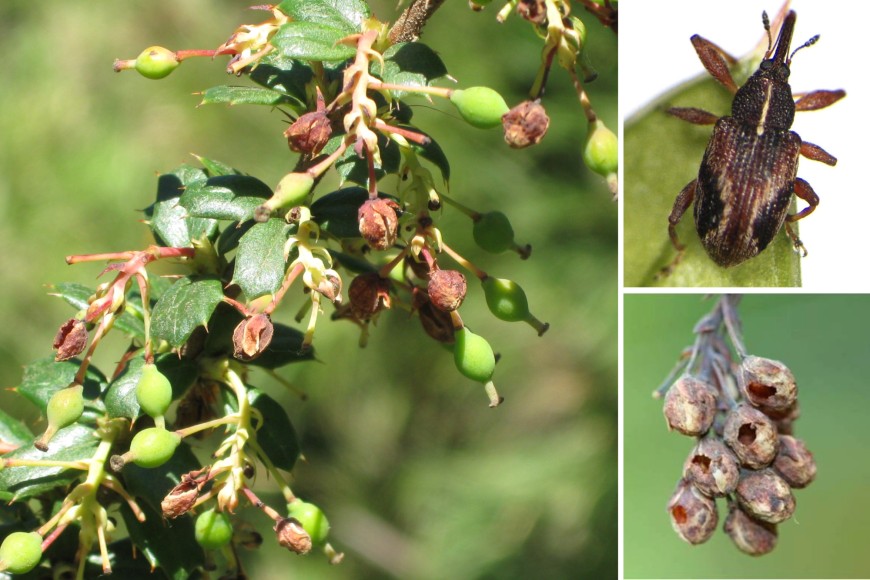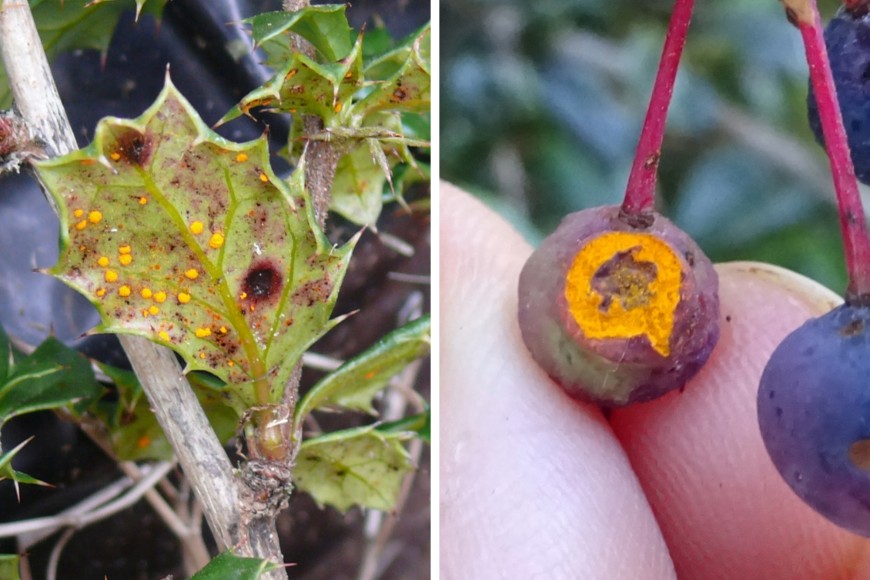Application to release Darwin’s barberry rust and Darwin’s barberry flower weevil

Darwin's Barberry (Berberis darwinii) (Image credit: Carolyn Lewis (Weedbusters))
The application seeked approval to introduce the Darwin’s barberry rust (Puccinia berberidis-darwinii) into Aotearoa-New Zealand as a biological control agent for Darwin’s barberry (Berberis darwinii). The Darwin’s barberry rust fungus damages Darwin’s barberry by infecting the leaves and fruits, reducing plant growth and seed production.
The application also seeked renewal of an expired EPA approval for the release of the Darwin’s barberry flower weevil (Anthonomus kuscheli) into Aotearoa-New Zealand as a biocontrol agent for Darwin’s barberry. In 2012, the EPA approved the release of this weevil species along with another species, the Darwin’s barberry seed weevil (Berberidicola exaratus), as biocontrol agents for Darwin’s barberry. Efforts to date have focussed on establishing the seed weevil, and the flower weevil was never released. Since the EPA approval lapsed, the application applied for a renewal of the approval based on the information contained in the original application as well as the EPA decision approving release of the flower weevil. These documents can be found on EPA’s website (HSNO application register | EPA).
Background
The application was submitted by Environment Canterbury, acting on behalf of the National Biocontrol Collective, a consortium of regional councils, unitary authorities, and the Department of Conservation. The Collective funds the development of weed biocontrol programmes in New Zealand. Manaaki Whenua – Landcare Research is the science advisor to the Collective for this application.
Darwin’s barberry is native to Chile and Argentina. It was first introduced to Aotearoa-New Zealand as an ornamental shrub in 1946 and is now common from central Te Ika-a-Māui (North Island) to Rakiura (Stewart Island). Darwin’s barberry is viewed as an expanding threat to environmental and economic values as it is still spreading. It invades farmland, forest margins, light gaps in disturbed or remnant forests, roadsides, and scrubland, outcompeting native plants.
Darwin’s barberry is a 5 m tall spiny shrub with deep orange-yellow flowers in January to December, followed by abundant purplish-black berries (Roy et al., 2004). Blackbirds and other species feed on fruits and then drop seed at a distance from the seed source, establishing satellite populations.
Currently, only Darwin’s barberry seed weevil (B. exaratus) has been released as biocontrol agent against Darwin’s barberry in Aotearoa-New Zealand. It was first released in 2015 and establishment has recently been confirmed at several sites in Southland and Wellington regions. This weevil destroys the fruits and seeds of its host plant.
If approval is granted for release of the Darwin’s barberry flower weevil, the damage caused by the two weevils will likely be additive. A reduction in flower and fruit production by the flower weevil is likely to reduce the resource available to the seed weevil (B. exaratus), increasing the proportion of seeds attacked within each fruit. By targeting the reproductive structures of the plant, these weevils will reduce the rate at which Darwin’s barberry is spreading.

Flower buds damaged by Darwin's barberry flower weevil (Anthonomus kuscheli) (on left and bottom right); adult (top right) (images provided by MWLR).
If approval is granted for release of Darwin’s barberry rust fungus, it is believed that the foliar rust fungus will affect the plant’s biomass and fruit production. This will contribute to the damage caused by the weevils, leading to greater impact on the weed.

Darwin's Barberry rust (Puccinia berberidis-darwinii) on leaves (on left); on fruits (on right) (photos provided by MWLR).
Identification and assessment of risks, costs, and benefits
The potential risks, costs and benefits associated with the proposed introduction of a foliar rust fungus, Puccinia berberidis-darwinii, and the flower weevil, Anthonomus kuscheli to Aotearoa-New Zealand and the possible reduction in the abundance, vigour and spread of Darwin’s barberry have been identified by literature review and by consultation with stakeholders.
- Risks, costs, and benefits of Darwin’s barberry biocontrol by the Darwin’s barberry rust – Report.
- Risks, costs and benefits of Darwin’s barberry biocontrol by the Darwin’s barberry flower weevil – Report from 2012 application.
The significant effects identified are highlighted in bold in the above reports and were fully addressed in the release application.
The potential benefits of biological control will be reducing biomass and fruit production in Darwin’s barberry plants, thereby mitigating the adverse effects of Darwin’s barberry on Aotearoa-New Zealand environment.
The key potential negative effects relate to impacts on native flora and fauna. These are addressed fully in the application and include:
- the risk of direct damage to native plants
- indirect effects on flora and fauna because of disruption of ecological relationships
Darwin’s barberry belongs to the plant family Berberidaceae. There are no native plant species in this family. The host range of the rust is restricted to Darwin’s barberry in New Zealand (see below - Report on host-range determination). Native and other valued plant species will not be at risk. Because the rust will be host specific, population densities capable of interacting significantly with other plants or animals will only be found near Darwin’s barberry infestations. As a result, no significant disturbance of ecological relationships is expected in New Zealand. Mechanisms for interaction are limited.
Host range tests with the flower weevil indicate that it is restricted to Darwin’s barberry and one other non-native, ornamental barberry species, Berberis thunbergii. The social and economic costs associated with possible attack and population build-up on B. thunbergii are addressed in the original application and applicant responses to submissions from stakeholders. Because the flower weevil has such a narrow host range, population densities capable of interacting significantly with other plants or animals will only be found in close proximity to Darwin’s barberry and potentially B. thunbergii. Mechanisms for interaction are limited. As a result, no significant disturbance of ecological relationships is expected in New Zealand.
Pre-application consultation with Iwi
The members of Te Herenga, the EPA's national network, will be contacted and invited to enter dialogue on plans to apply to the EPA to introduce the biocontrol agents for Darwin’s barberry.
The message to Te Herenga will describe how the applicant intends to assess the risks, costs and benefits associated with the proposed introduction. Members will be invited to identify any issues that they would like to be addressed in the application. Further consultation will be undertaken by Otago Regional Council and Manaaki Whenua - Landcare Research.
At the request of the applicant, the EPA convened a reference group from Te Herenga to meet and discuss the issues surrounding the proposed applications. The application will address principles identified in that report.
Pre-application consultation with other organisations
Other organisations that will be consulted while preparing this application include:
- Federated Farmers
- Royal Forest and Bird Protection Society of New Zealand
- Department of Conservation
- QEII National Trust
- NZ Landcare Trust
- Apiculture NZ
- Nursery and Garden Industry Association of NZ
- NZ Plant Producers Industry
Key documents
Report on host-range determination
Safety issues are paramount to the development of biocontrol for weeds. Researchers rigorously test all proposed agents to assess the risk of damage to non-target plants. A set of procedures helps researchers choose a suitable shortlist of test plants, and this methodology is now well-accepted internationally (Wapshere, 1974). The technique is under constant review to update best practice (e.g. Sheppard et al., 2005; Briese, 2005).
Barton (2004, 2012) has reported that rust fungi can be safe and effective biocontrol agents for weeds.
Darwin’s Barberry rust:
Darwin’s Barberry flower weevil:
The results of host range testing conducted in Chile and New Zealand are summarised in Tables 1-3 of the 2012 application. The unpublished reports on which that summary was based (Norambuena & Escobar, 2010; Norambuena, 2011; Smith 2012) have been peer-reviewed by Dr Q. Paynter of Landcare Research, and that review has been provided to EPA.
Cited References
Barton J. 2004. How good are we at predicting the field host-range of fungal pathogens used for classical biological control of weeds? Biological Control 31: 99-122.
Barton J. 2012. Predictability of pathogen host range in classical biological control of weeds: an update. Biocontrol 57: 289-305.
Briese D. 2005. Translating host-specificity test results into the real world: The need to harmonize the yin and yang of current testing procedures. Biological Control 35: 208–214.
Roy GB, Popay I, Champion P, James T, Rahman A (2004). An illustrated Guide to Common Weeds of New Zealand. New Zealand Plant Protection Society, 314p.
Sheppard AW, Heard TA, van Klinken RD. 2005. Scientific advances in the analysis of direct risks of weed biological control agents to non-target plants. Biological Control 35: 215–226.
Wapshere AJ. 1974. A strategy for evaluating the safety or organisms for biological weed control. Annals of Applied Biology 77: 201–211.

